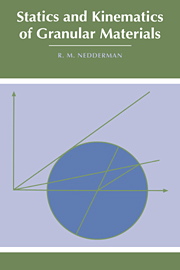Book contents
- Frontmatter
- Contents
- Notation
- 1 Introduction
- 2 The analysis of stress and strain rate
- 3 The ideal Coulomb material
- 4 Coulomb's method of wedges
- 5 The method of differential slices
- 6 Determination of physical properties
- 7 Exact stress analyses
- 8 Velocity distributions
- 9 The Conical yield function
- 10 The prediction of mass flow rate
- Set problems – chapters 2–10
- Appendices
- References and bibliography
- Index
6 - Determination of physical properties
Published online by Cambridge University Press: 28 October 2009
- Frontmatter
- Contents
- Notation
- 1 Introduction
- 2 The analysis of stress and strain rate
- 3 The ideal Coulomb material
- 4 Coulomb's method of wedges
- 5 The method of differential slices
- 6 Determination of physical properties
- 7 Exact stress analyses
- 8 Velocity distributions
- 9 The Conical yield function
- 10 The prediction of mass flow rate
- Set problems – chapters 2–10
- Appendices
- References and bibliography
- Index
Summary
Introduction
In the previous chapters we have assumed that we know the physical properties of the material such as the bulk density and the parameters of the yield functions. In practice these have to be determined experimentally and in this chapter we will consider the methods available for this. However, little attention will be paid to the details of the experimental techniques since these have been adequately discussed elsewhere, for example in the Powder Testing Guide by Svarovski (1987) or the Report of the European Federation of Chemical Engineers on the Mechanics of Paniculate Solids, EFCE Working Party (1989). Furthermore, since many of the properties are measured with commercially available equipment, the manufacturer's handbook is usually the best source of information on the experimental method. Instead, we will concentrate on the interpretation of the experimental results.
We will consider the determination of the material density and the related topic of consolidation in §6.2 and pay attention to the measurements of particle size and particle size distributions in §6.3. In §6.4 we will consider the percolation of fluid through granular media and present relationships for the permeability. Finally in §6.5 to §6.7 we will discuss the measurement of the failure properties of the material and discuss these in terms of the Critical State Theory as expounded by Schofield and Wroth (1968). The interpretation of yield data is somewhat controversial and it is hoped that the present account is a dispassionate discussion of the various alternatives.
- Type
- Chapter
- Information
- Statics and Kinematics of Granular Materials , pp. 127 - 162Publisher: Cambridge University PressPrint publication year: 1992



